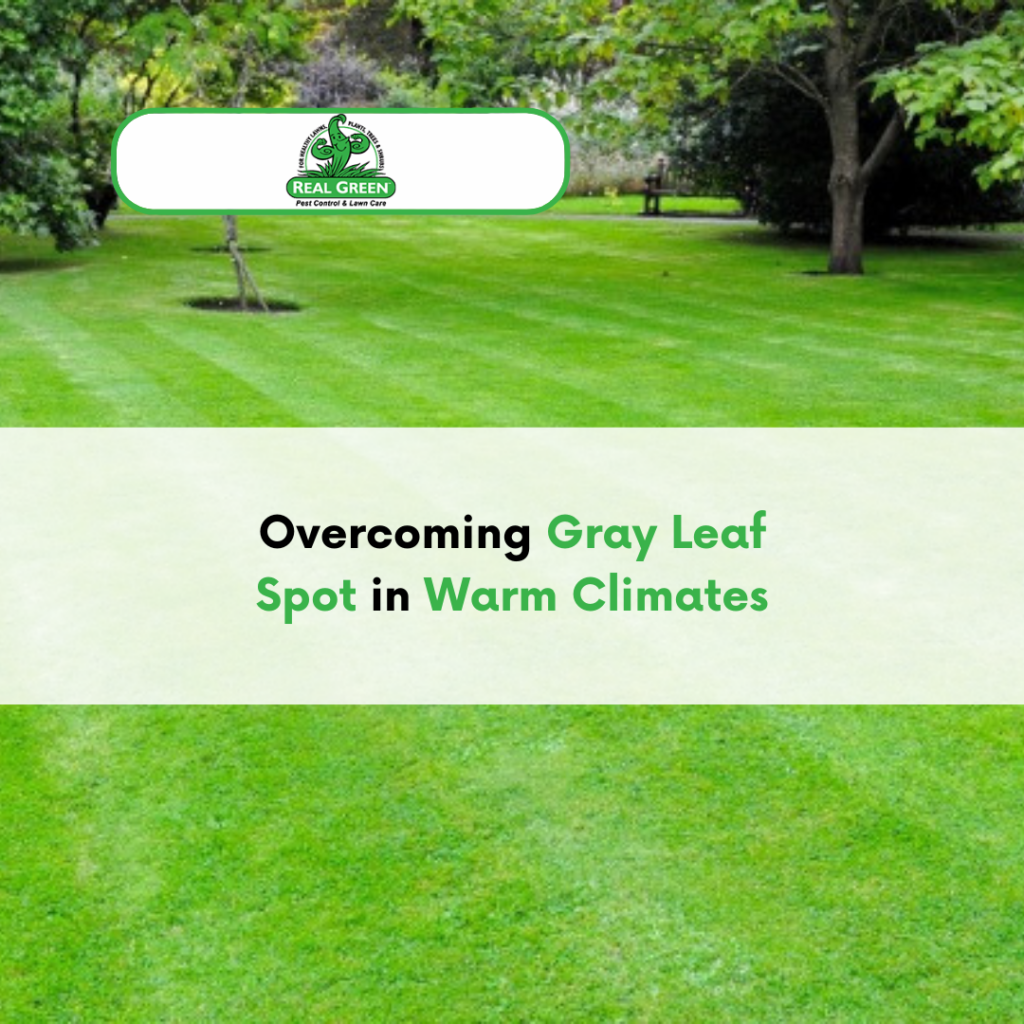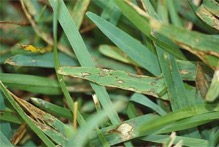
Overcoming Gray Leaf Spot in Warm Climates
Understanding Gray Leaf Spot
Gray Leaf Spot is a common lawn disease that plagues warm-season grasses, particularly in regions like Austin where the climate is conducive to its development. This fungal disease can quickly turn a lush, green lawn into a patchy and unattractive mess if not identified and treated promptly. Homeowners in warm climates often find themselves struggling to maintain the health and appearance of their lawns due to the prevalence of Gray Leaf Spot, but there are effective strategies that can help.
In this comprehensive guide, we will explore the causes, symptoms, and effective treatments for Gray Leaf Spot. By understanding the factors that contribute to this disease and implementing proactive measures, you can protect your lawn from its devastating effects. Whether you are dealing with an active outbreak or looking to prevent future occurrences, Real Green is here to help you achieve and maintain a vibrant, healthy lawn.
Gray Leaf Spot is a fungal disease that affects warm-season grasses, particularly St. Augustine and Bermuda grass. This disease is caused by the fungus Pyricularia grisea and thrives in warm, humid conditions. It can quickly spread across your lawn, leading to unsightly spots and patchy growth. Understanding what causes Gray Leaf Spot is crucial for effective management and prevention.

Causes of Gray Leaf Spot
Gray Leaf Spot develops under specific conditions. Knowing these can help you better understand how to manage and prevent this disease from taking over your lawn.
Warm, Humid Weather: The fungus thrives in temperatures between 70°F and 90°F and high humidity levels. These conditions are typical in regions like Austin, especially during late spring and summer.
Excessive Nitrogen Fertilization: Applying too much nitrogen can make grass blades more susceptible to fungal infections. Fast, lush growth provides an ideal environment for the fungus to take hold and spread.
Poor Air Circulation: Dense growth and excessive thatch can limit the airflow around the grass blades, creating a moist environment where the fungus can thrive.
Overwatering: Watering too frequently or late in the day can leave the grass blades wet for long periods, increasing the risk of fungal infection.
Identifying Gray Leaf Spot
Early identification of Gray Leaf Spot is key to controlling its spread. Recognizing the symptoms will help you take swift action to manage the disease.
Leaf Spots: The first signs are small, round spots on grass blades that are usually tan or gray in the center with dark borders. As the disease progresses, these spots can enlarge and merge, killing large sections of the grass blade.
Yellowing: Infected areas may turn yellow or brown, giving the lawn a scorched appearance. This discoloration can spread rapidly under favorable conditions.
Thinning Grass: As the disease advances, affected areas may thin out and die, leading to patchy and weakened turf.
Preventing Gray Leaf Spot
Preventing Gray Leaf Spot requires a combination of good cultural practices and timely interventions. Here are some practical steps you can take to reduce the risk of this disease.
Proper Watering: Water your lawn early in the morning, allowing the grass blades to dry throughout the day. Avoid watering late in the afternoon or evening to prevent prolonged leaf wetness.
Balanced Fertilization: Apply nitrogen fertilizers at recommended rates and intervals. Avoid excessive use of nitrogen, as it can promote conditions favorable for fungal growth. Balanced fertilizers ensure your grass gets the nutrients it needs without overfeeding.
Mowing Practices: Mow your lawn regularly at the recommended height for your grass type. Keep mowing blades sharp to avoid damaging the grass and creating entry points for the fungus. Remove clippings if the disease is present to prevent spreading spores.
Thatch Management: Thatch is the layer of dead grass and roots that build up between the soil and growing grass. Excessive thatch can create an environment where fungi thrive. Regularly dethatch your lawn to improve air circulation and reduce disease risk.
Treating Gray Leaf Spot
If your lawn shows signs of Gray Leaf Spot, taking prompt action can help control and eliminate the infection. Here are some effective treatments for managing this disease:.
Fungicide Application: Chemical fungicides are the most effective way to treat Gray Leaf Spot. It’s important to apply fungicides at the first sign of disease and follow the label instructions for the correct application rate and frequency. Rotating fungicides with different active ingredients can help prevent the fungus from developing resistance.
Adjust Watering and Mowing: Modify your watering schedule to reduce moisture on the grass blades. Mow your lawn more frequently, but keep the grass at a healthy height. Remove and properly dispose of infected clippings.
Improve Lawn Health: Maintaining overall lawn health can help it recover from disease and resist future infections. Aerate the soil to improve root growth and water penetration. Trim back overhanging branches and improve air circulation to ensure your lawn is receiving adequate sunlight.
Monitoring and Maintenance
Regular monitoring and maintenance are key to preventing Gray Leaf Spot from reoccurring. Follow these practices to keep your lawn healthy and disease-free.
Frequent Inspections: Regularly inspect your lawn for signs of disease, especially during warm, humid weather. Catching and treating diseases early can prevent significant damage.
Consistent Care: Stick to a consistent lawn care routine that includes proper watering, mowing, fertilizing, and aerating. Healthy grass is more resilient to diseases and better able to recover if issues arise.
Lawn Care Products: Use high-quality lawn care products that are suited to the needs of your specific grass type. Products designed for disease resistance can help strengthen your lawn against fungal infections.
The Role of Environmental Factors
Environmental factors play a significant role in the onset and spread of Gray Leaf Spot. Understanding these elements can help you take preventive measures that keep your lawn healthy.
Temperature and Humidity: Gray Leaf Spot is prevalent in temperatures ranging from 70°F to 90°F along with high humidity. These conditions are ideal for the fungus to grow and spread. Hot, humid summers, common in Austin, create a perfect breeding ground for the disease. Monitoring your lawn during these times can help catch early signs of infection.
Rainfall: Frequent rain can make lawns more susceptible to Gray Leaf Spot by keeping the grass blades wet for extended periods. Excessive moisture creates an optimal environment for fungal spores to germinate and infect your lawn. After heavy rains, make sure your lawn dries out to prevent fungal growth.

Shade and Poor Drainage: Lawns with poor drainage or excessive shade can have increased moisture levels, which is ideal for fungal development. Ensure your lawn has good drainage and receives adequate sunlight by trimming back overgrown trees and shrubs. Proper air circulation and sunlight exposure help grass dry out more quickly and reduce the risk of infection.
Common Missteps in Lawn Care
Certain lawn care practices can contribute to the spread of Gray Leaf Spot. By adjusting these practices, you can create an environment less favorable for fungal diseases.
Over-Fertilizing: Applying too much nitrogen fertilizer can promote rapid, lush growth that is more susceptible to fungal infections. Stick to a balanced fertilization schedule, and use fertilizers that meet your lawn’s specific needs. Slow-release fertilizers can be beneficial as they provide a steady supply of nutrients without causing excessive growth.
Improper Mowing: Cutting the grass too short or neglecting to sharpen mower blades can stress your lawn and create open wounds that are entry points for the fungus. Mow at the recommended height for your grass type and keep your blades sharp to avoid injuring the grass.
Excessive Watering: Watering your lawn too frequently or late in the day can cause prolonged leaf wetness, which fosters fungal growth. Water deeply but infrequently, and do so in the morning to allow the grass to dry throughout the day.
Effective Fungicide Treatments
Chemical fungicides are crucial in managing and controlling Gray Leaf Spot. These treatments are designed to kill the fungus and prevent its spread, ensuring that your lawn remains healthy and green.
Choosing the Right Fungicide: Select a fungicide that is specifically labeled for Gray Leaf Spot. Common active ingredients include chlorothalonil, azoxystrobin, and propiconazole. Be sure to read and follow the label instructions for safe and effective application.
Application Timing: Apply fungicides at the first sign of disease to prevent the fungus from spreading. Follow-up applications may be necessary, especially during periods of favorable conditions for fungal growth. Rotating fungicides with different active ingredients can prevent the development of fungicide-resistant strains.
Safety Precautions: Always wear protective gear when applying fungicides to protect yourself from exposure. Make sure to keep children and pets off the treated lawn until the fungicide has fully dried and is safe.
Integrated Lawn Care Practices
Integrating good lawn care practices with fungicide treatments can enhance disease control and reduce the likelihood of future outbreaks.
Aeration and Dethatching: Regularly aerate your lawn to improve soil drainage and reduce compaction. This helps water penetrate the soil more efficiently and reduces surface moisture. Dethatching removes the layer of dead grass and roots that can harbor fungal spores and impede healthy growth.
Proper Irrigation Management: Implementing a smart watering schedule can significantly reduce the risk of Gray Leaf Spot. Water your lawn deeply and less frequently, allowing the soil to dry out between watering sessions. This practice promotes deep root growth and reduces surface moisture.
Healthy Lawn Practices: Maintaining a balanced approach to feeding, mowing, and watering your lawn creates a more resilient grass that can better withstand diseases. Healthy, well-maintained grass is less likely to suffer from severe damage, even if it does get infected.
Monitoring and Early Detection
Preventing severe outbreaks of Gray Leaf Spot involves closely monitoring your lawn and detecting problems early.
Regular Inspections: Make it a habit to inspect your lawn regularly, especially during warm and humid periods. Look for early signs of the disease, such as small spots on the grass blades. Early detection allows for prompt treatment and can prevent widespread damage.
Consistent Lawn Care Routine: Sticking to a consistent lawn care routine helps maintain overall lawn health and reduces the stress that makes grass more susceptible to diseases. Regular mowing, watering, and fertilizing keep your grass vigorous and capable of resisting infections.
Lawn History: Keeping a record of your lawn care activities, including fertilization schedules, fungicide applications, and any pest problems, can help you identify patterns and make informed decisions about future care.
Resilient Lawn Varieties
Choosing disease-resistant grass varieties can provide an extra layer of protection against Gray Leaf Spot. Some grass types are less susceptible to fungal diseases and can help minimize the impact of infections.
Resistant Cultivars: When planting or overseeding your lawn, consider using cultivars that have shown resistance to Gray Leaf Spot. Consult with local experts to find the best options for your region and lawn conditions.
Proper Blending: Mixing different grass species and cultivars can increase the overall resilience of your lawn. A diverse lawn is less likely to suffer extensive damage from a single disease, keeping it healthier over the long term.
Ensuring a Healthy, Vibrant Lawn
Gray Leaf Spot can be a challenging lawn disease, but with the right knowledge and proactive measures, you can effectively manage and prevent it. Implementing good cultural practices, selecting resistant grass varieties, and utilizing appropriate fungicides can keep your lawn healthy and vibrant. Monitoring your lawn regularly and making seasonal adjustments to your care routine will further enhance its resilience against fungal diseases.
For homeowners looking for professional assistance, Real Green offers expert lawn care services tailored to your specific needs. Our team of specialists is equipped to diagnose and treat Gray Leaf Spot efficiently, ensuring your lawn remains lush and attractive year-round.
Don’t let Gray Leaf Spot take away the beauty of your lawn. Invest in professional care and enjoy a healthy, green yard with Real Green. Contact us today to find out how we can help you achieve the lawn of your dreams with our Gray Leaf Spot treatment solutions and more.
